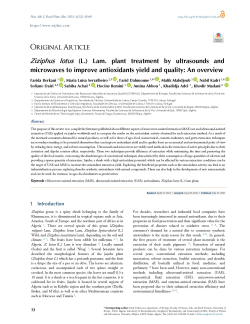Main Article Content
Ziziphus lotus (L.) Lam. plant treatment by ultrasounds and microwaves to improve antioxidants yield and quality: An overview
Abstract
The purpose of this review is to compile the literature published about different aspects of microwave-assisted extraction (MAE) use and ultrasound-assisted extraction (UAE) applied on jujube worldwide and to compare the results on the antioxidant activity obtained for each extraction method. As a result of the increased consumers demand for natural products, as well as for those of agro-food, nutraceutical, cosmetic industries, and green extraction techniques are nowadays trending to be potential alternatives that can improve antioxidant yield and its quality from an economical and environmental point of view by reducing time, energy, and solvent consumption. Ultrasounds and microwaves are widely used methods in the extraction of active principles due to their cavitation and dipolar rotation effect, respectively. These two techniques provide efficiency of extraction while minimizing the time and preserving the quality of the food matrix, overcoming the disadvantages of conventional techniques characterized by their consumption of large quantities of solvents and providing a sparse quantity of extraction. Jujube, a shrub with a high antioxidant potential, which can be affected by various extraction conditions can be the target of UAE and MAE to increase the antioxidant extraction yield. Exploiting the beneficial properties such as the antioxidant activity can lead to an industrialization process, replacing therefor synthetic antioxidants with natural compounds. These can also help in the development of new nutraceuticals and can be used, for instance, in agro-food industries as preservatives.







